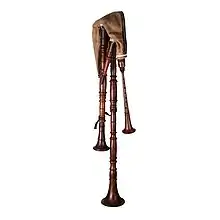Marktsackpfeife
The Marktsackpfeife (or "Market bagpipe") is a visual reconstruction of German medieval bagpipes particularly described as being used in market busking. Created using historical descriptions by Michael Praetorius, Albrecht Dürer as well as numerous other medieval depictions. While the exterior is reconstructed from these sources, the interior has its own distinct characteristics: GHB, Bombard and own ideas has been merged into a new design by pipe makers Klaus Stecker and Roman Streisand in the early 1980s creating a modern bagpipe with no historical counterparts. "Medieval Pipes" is thus a misnomer, since no actual bagpipes from the Middle Ages have survived. The sound is often similar to the Scottish Great Highland Bagpipe, due to the widespread use of GHB-reeds, although own reeds (Arundo donax, PE and PS) are also used by pipe makers. The main distinction between the Scottish Great Highland Bagpipes and Marktsackpfeife lies in its internal bore - GHB features a conical bore with a linear profile, while the other one often possess a slightly parabolic non-parallel bore, which often results in a sound somehow similar to an oriental Zurna. Commonly tuned in A-Dorian/A minor it is pitched in a' 440 Hz and used by musical groups specialising in medieval tunes. Often to be seen at medieval festivals and markets.

As translated from DBV Musik, a German folkmusic community and resource,
"The first images of this instrument date from the Middle Ages and the Renaissance. Over the centuries, however, the instrument has disappeared from the scene in Germany. Medieval instruments only began to be reconstructed in the 1970s. Since there were no construction plans or other detailed records, the focus was primarily on visual materials. The recorder was used as the mood.
The music historian Roman Streisand played a key role in the reconstruction. He wanted to construct the instrument in such a way that it reached at least the volume of the Scottish “Great Highland Bagpipe” and could therefore also be used by him and his ensemble during open-air performances without amplification.
To make this possible, a steeper cone was used on the chanter. Since efforts were made to preserve the original look, the bagpipes were created with a fifth and octave bordum in a forked double wooden stick.
If you compare the result of the reconstructions with the chanter from the late Middle Ages, you will hear that the pitch does not quite match the original. However, when reconstructing the market bagpipes, it was also necessary to take into account that medieval music had to be adapted to modern listening habits, so that the bagpipe fits perfectly into the picture.
Due to the high volume, it is almost impossible to play the instrument in a small room. Recorders with German fingering are often used for practice purposes and to practice new pieces.
Actually, an alto recorder is better suited due to the handle clearances, but these also cost many times more than the soprano recorders.
The market bag pipe is used by many medieval bands today. Since most of the reconstructed instruments were made in the former GDR, the market bagpipe is also called the Eastern horn, a bit derogatory."[1]
References
- "Die Marktsackpfeife, der deutsche Dudelsack". Dbv-musik.de. 2016-05-14. Retrieved 2020-12-21.